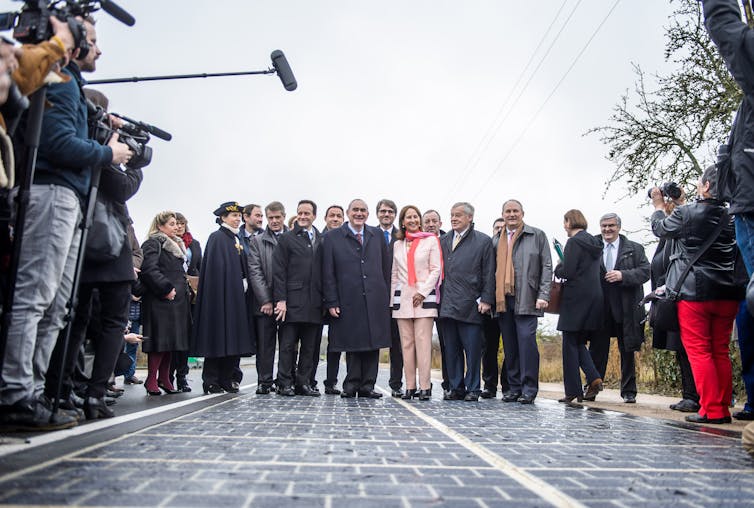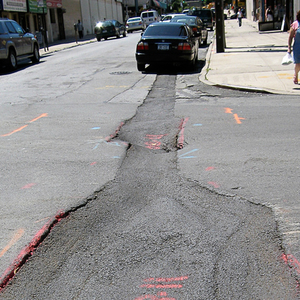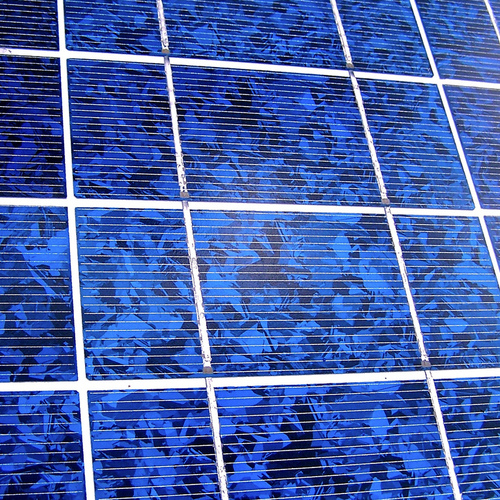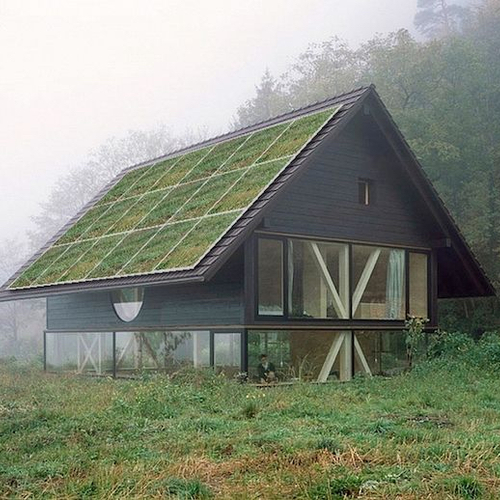
Four years ago, a viral campaign wooed the world with a promise of fighting climate change and jump-starting the economy by replacing tarmac on the world’s roads with solar panels. The bold idea has undergone some road testing since then. The first results from preliminary studies have recently come out, and they’re a bit underwhelming.
A solar panel lying under a road is at a number of disadvantages. As it’s not at the optimum tilt angle, it’s going to produce less power, and it’s going to be more prone to shading, which is a problem as shade over just 5% of the surface of a panel can reduce power generation by 50%.
The panels are also likely to be covered by dirt and dust, and would need far thicker glass than conventional panels to withstand the weight of traffic, which will further limit the light they absorb.
Because the panels are unable to benefit from air circulation, it’s inevitable that they will heat up more than a rooftop solar panel would. For every 1°C over optimum temperature the panel will lose 0.5% of energy efficiency.
As a result, a significant drop in performance for a solar road compared to rooftop solar panels has to be expected. The question is, by how much? And what is the economic cost?
The road test results are in
One of the first solar roads to be installed is in Tourouvre-au-Perche, France. This road has a maximum power output of 420 kW, covers 2,800 square meters, and cost €5 million to install. This implies a cost of €11,905 ($13,745) per installed kW.
While the road is supposed to generate 800 kilowatt hours per day (kWh/day), some recently released data indicates a yield closer to 409 kWh/day, or 150,000 kWh/yr. For an idea of how much this is, the average UK home uses around 10 kWh/day. The road’s capacity factor – which measures the efficiency of the technology by dividing its average power output by its potential maximum power output – is just 4%.

In contrast, the Cestas solar plant near Bordeaux, which features rows of solar panels carefully angled towards the sun, has a maximum power output of 300,000 kW and a capacity factor of 14%. And at a cost of €360 million ($415.6 million) or €1,200 ($1,385) per installed kW, one-tenth the cost of our solar roadway, it generates three times more power.
In America, a company called Solar Roadways has developed a smart highway with solar panels, including sensors and LED lights to display traffic warnings about any upcoming hazards, such as a deer. It also has heating pads to melt snow in winter.
Several of their SR3 panels have been installed in a small section of pavement in Sandpoint, Idaho. This is a 13.9-square-meter area, with an installed capacity of 1,529 Kw. The installation cost is given as $48,734, which implies a cost per installed kW of €27,500 ($31,700), more than 20 times higher than the Cestas powerplant.
Solar Roadway’s own estimates are that the LED lights would consume 106 MWh per lane mile, with the panels generating 415 MWh – so more than 25% of the useful power is consumed by the LEDs. This would reduce performance even further. The heating plates are also quoted as drawing 2.28 MW per lane mile, so running them for just six days would cancel out any net gain from the solar panels.
And this is before we look at the actual data from the Sandpoint installation, which generated 52,397 kWh in 6 months, or 104,800 kWh over a year. From this we can estimate a capacity factor of just 0.782%, which is 20 times less efficient than the Cestas power plant.
That said, it should be pointed out that this panel is in a town square. If there is one thing we can conclude, it’s that a section of pavement surrounded by buildings in a snowy northern town is not the best place to locate a solar installation. However, perhaps there’s a bigger point: solar roads on city streets are just not a great idea.
Running out of road
Roads don’t actually represent as large an area as we assume. The UK department of transport gives a breakdown of the length of the UK’s different road types.
Assuming we can clad these in solar panels, four lanes of every motorway, two lanes on the A & B roads and half a lane for C & U roads (a lot are single track roads and just won’t be suitable), we come up with a surface area of 2 billion square meters.
Which sounds like a lot, until you realize that buildings in the UK’s urban areas occupy an area of 17.6 billion square meters. So just covering a fraction of the UK’s rooftops with solar panels would immediately yield more power than putting them on roads. That’s quite apart from the benefits that a more elevated position would yield for greater power generation.
All of this suggests that only a small fraction of the road network would actually be suitable. And, given the relatively small size of the road network, solar roads could only ever become a niche source of power and never the shortcut to our future energy supply.
Dylan Ryan is a lecturer in mechanical and energy engineering at Scotland’s Edinburgh Napier University. This post originally appeared at The Conversation.
Weekly Newsletter
Get building science and energy efficiency advice, plus special offers, in your inbox.















30 Comments
Very interesting analysis
The $13,745 per kW is nuts but how much does a road cost for the same distance? I'm guessing this still won't make it cost effective but i am curious the numbers
"Solar Panels Don’t Make Good Roads"
And in other news, water is wet. This article barely scratches the surface at the sheer stupidity of this idea. It never should have made it past the concept stage. The fact that millions of dollars was collected from governments and credulous crowd funding dupes almost makes me weep for the human race.
What a surprising result!?! Who knew? (Other than just about everyone with even a cursory understanding of the economics of solar, that is... ;-) )
It was an interesting set of technology challenges, but no more a "solution" than putting large solar panel arrays in orbit and transmitting the power generated to earth stations via microwave (an idea that captured some of the public imagination 40+ years ago, but didn't have access to online project funding websites.)
I have always been flabbergasted by this solar roadway proposal. Wouldn't it be easier and cheaper to just set up a bunch of standard solar collectors in the highway median rather than make the roadway out of them? Anyone who has designed products (in my case, electronics) for vehicle use learns that the roadway is an extremely harsh environment to deal with -- temperature extremes, dust, gravel, oil and other chemicals, de-icing chemicals, vibration, impact, extra stress from vehicles accelerating or brakes being slammed, etc. Why subject solar collectors to all of that? Again, many of these problems go away by placing collectors in less stressful places.
Terrible solar energy installation, yes.
But a road that lights itself, thaws itself, and isn’t covered in potholes 2 years later may have value. I wonder what the long term cost analysis is?
Thunderfoot has a very thorough debunking of the whole concept on youtube. Just the tempered glass alone would be ten times the entire GDP of the US.
Your concern about potholes is somewhat amusing, as it implies this solar roadway would require LESS maintenance than a pavement road. The reality is the opposite. We're talking multiple orders of magnitude more maintenance for the solar roadway.
Then you have to take a look at how well this surface is going to be at its primary function, and it's not good. Honestly, once you dig into all the details, it's hard to imagine a worse idea. Like, literally, if you suggested making roads out of marshmallows it wouldn't be any stupider.
Fair enough. Oil soaked marshmallows- that is what I think of asphalt. But I’ll look for better roads elsewhere.
The long term cost, relative to the delivered BENEFIT you mean?
It's clearly a negative number, and not by a little bit.
In 2014 Holland they installed a short stretch of bike road (less than 100 yards) with that junk, and in 2016 added a tiny bit more. For the same money they could have installed about a kilometer of solar awning over that road, keeping the surface (and riders) drier- less slick and more comfortable, with a much bigger energy uptake. That's clearly worth more than a few lights (which could also be installed on the under-side of a solar awning for less money and easier maintenance than when embedded in a road.)
Yet another reminder that it's not as simple as "green is good". Cost efficiency matters and this was a missed opportunity to do a lot more for the environment at less cost.
Jon,
I'm not sure whether the "green is good" philosophy (whatever that means) had anything to do with this fiasco.
The real lesson is simpler: A little common sense is always good. There wasn't much common sense employed here.
>There wasn't much common sense employed here.
No kidding! Common sense need not apply!
From a 2017 CleanTechnica blog covering that gazillion Euro piece of Dutch solar-freakin' bikeway:
"To reiterate: the SolaRoad does not have to reach cost parity with rooftop or utility-scale solar, but the more solar electricity we can generate via cost-competitive means versus the alternative, the better. If we were to travel a decade or so into the future, most available rooftop space might already be covered. So, to further increase solar generation capacity at that time, either land reserved for agriculture or nature would have to be used, or surfaces such as bike paths could be considered."
https://cleantechnica.com/2017/03/12/dutch-solar-bike-path-solaroad-successful-expanding/
Really? What's that again- "... a decade or so into the future, most available rooftop space might already be covered..."? HUH!?!
According to a 2015/2016 NREL technical survey of US rooftop PV suitability & area, utilizing all suitable rooftop area would deliver over 35% of annual US power needs. (See Table ES-1 and Figure ES-2: https://www.nrel.gov/docs/fy16osti/65298.pdf ) For the grid to accommodate even half that much without massive power curtailment in the shoulder seasons would require a massive grid storage build out.
A more likely scenario were we to "...travel a decade or so into the future..." is that perovskite PV on silicon PV hybrids will raise the output per square meter by about 50% and quite a bit cheaper per watt, and the 38.6% potential would be more like 55-60% of annual consumption sourced by rooftops and even harder to manage on the grid.
Not to mention that solar carports are already substantially cheaper than rooftop solar, which is in turn DRAMATICALLY cheaper than solar roadways will ever be. Solar roadways really DO have to become cost-competitive with the alternatives to be viable, something that just can't happen.
Even in foggy dew densely populated Holland it makes no sense to embed solar into pavement when covering suitable paved areas with solar awnings makes is so much cheaper & more effective. There's no added value to putting it in the pavement, only added cost. And it's obvious to anyone with common sense why this would be true.
I read somewhere that wind turbines might work pretty well on the flat Rhine delta, downwind of the North Sea too...
Solar awnings seem like an interesting idea. I can imagine parking lots with them, keep cars cooler saving some AC cool down energy and reduce active cooling of EV's batteries by some amount as well.
I've seen such parking lot awnings in the Phoenix area. I've also seen at least one roof with solar panels elevated some way above the roof, which I figured was to shade the roof and lessen the needed cooling load, but (a) I am not sure that was why (this was in a climate with much lower need for A/C) and (b) I would worry about the shaded roof getting taken over by birds.
Alan,
You don't have to "imagine" parking lots with solar awnings. In many states, they are becoming common.
Very nice, though i have never seen one in real life and there are many apartments and big box stores and parking lots out there that could produce a boatload of electricity if these are installed everywhere.
Common Cents is overrated.
Rooftop residential solar is more expensive and produces less useful energy than community solar projects, but they still make money for homeowners and the suppliers. Surely somebody can profit from solar roads.
Only the manufacturers & installers of the solar roads are going to profit from solar roads.
Rooftop residential solar is only 2-3x more expensive than larger ground mounted community solar arrays. Solar roads are ORDERS OF MAGNITUDE more expensive than community solar or solar awnings/carports , and higher maintenance too.
It's not hard math. Spending ~125 times per installed-watt the cost community solar or ~50 times the cost of rooftop solar, while reaping substantially less energy per watt out is never going be profitable for the buyer.
While solar roads are clearly not a good idea, I get frustrated when I hear arguments against roof top solar based on first cost and efficiency. Not every roof is ideal for solar, but we cannot cover half the earth in buildings and roads, and the other half in ground mounted solar because it's cheaper and more efficient. I think we're taking up enough space as it is.
I can think of a couple ground mounted arrays near me within site of a parking lots equal in size. We're going to have to do a better job of this.
Although Tesla's solar roof may not be "the one" and other products have struggled to catch on, some kind of integrated solar roofing seams like an eventual must. All I know is all the roof top solar in my area is going to out live the asphalt shingles next to it. That's going to be a pain to deal with.
If all the money spent on these roads went into developing rock solid high output solar roofing, we'd be a lot further ahead.
Is that what people are proposing?
Covering half the earth with buildings and half with ground mounted solar?
What does this mean: "I can think of a couple ground mounted arrays near me within site of a parking lots equal in size."
If you are suggesting covering parking lots with solar, in the real world, if you are going to cover a parking lot with solar, it can be oriented to provide optimal energy output, unlike mounting to existing housing.
Forgive me, I was exaggerating to make a point. How about this, I worry that prioritizing first cost and capacity factors may come at the expense of other criteria such as wise use of land. I picture every suburban neighborhood with a field of PV next to it because it was cheaper that way. Here we are trying to reduce our carbon foot print and we're covering land that could be growing trees with rows of PV.
Yes, I am suggesting we do a better job of connecting people building parking lots with people installing PV.
The relevance to this article is that the solar road attempts to make use of land being developed anyway to generate electricity, unlike ground mounted solar. Solar roads just happen to be the worst possible way to do it.
>"Not every roof is ideal for solar, but we cannot cover half the earth in buildings and roads, and the other half in ground mounted solar because it's cheaper and more efficient. "
NREL's 2015 (published January 2016) survey of all roofs in the US shows that about 39% of all power generated in the US could be sources from JUST the suitable rooftops.
https://www.nrel.gov/docs/fy16osti/65298.pdf
Solar awning parking lots would just be the easy gravy, but there's clearly no need to clear trees to make way for solar.
When solar was expensive people figured to maximize ROI solar needed to be built in sunny deserts and open spaces at large scale. That's still a cheaper way to build than rooftops & parking lots, but there are substantial grid connection costs that go along with it, and dangling a power plant on the end of a string far from the load isn't as reliable/robust as siting solar within the distribution grid. The "value of solar" varies quite a bit by it's location within the distribution grid, but it's still more robust way to go even at fairly high penetration rates, given sufficient smart-load (home batteries, water heaters, smart EV chargers) to soak up the mid-day excesses.
PV over asphalt shingles protects the shingles from the elements, and they'll outlive their warranty by a huge amount. The parts of the roof that may need re-roofing are still pretty accessible. The warranty period of shingles in comparable to the anticipated lifecycle of PV, though some PV can still outlive the average by 2x or more.
If you're going to write an article about solar roads, then doesn't that mean there should be a comparison to a combined road and solar and not just a solar power plant? Solar roads may very well be a terrible idea, but let's use some intellectual honesty and show why and not just a strawman of only power generation.
When you're talking more than an order of magnitude more expensive than a powerplant the comparative cost of a standard road is "in the statistical noise" of all the rest. The maintenance cost of a solar road has to be substantially higher than standard road construction too- that glass isn't going to have enough traction forever, and would have to be resurfaced for safety.
Do you have evidence to back up those assertions?
A mile of new highway in the US costs about $2-5 million/mile for 2 lane undivided and $4-10 million/mile for 4 lane divided. The solar power plant in this article cost $416 million, which is equivalent to somewhere around 40-200 miles of highway. That doesn't seem like statistical noise to me.
Like I said, solar roadways may be a terrible idea, but you can't show that from this article as there's not even an attempt to analyze the roadway costs.
EDIT: forgot the link to highway costs: https://medium.com/@TimSylvester/i-agree-it-sounds-astronomical-but-i-actually-understated-the-costs-according-to-artba-2e8baeac2a46
I've actually got to side with Jason D here. If you're going to discredit a bad idea you still need to do so properly. "Statistical noise" or not the cost of the road that was going to be there anyway needs to be backed out; the whole point of the technology is two birds with one stone. You may even need to back out the land value (economic and ecological) of an equivalent ground mount array. Could that land by Bordeaux have been growing Pinot? Comparative maintenance over time is absolutely a factor as well. Worth noting that Prototypes are always more costly than production.
Bad idea? Almost Certainly. Good analysis? Not so much.
This work has been done elsewhere. The feasibility of solar roads is actually far, far worse than depicted in this article. So while it's not comprehensive, it's not really accurate to call the article a straw man argument. In this case, the straw man is made of tougher stuff than the actual man.
Sure it's statistical noise.
If the solar road costs 10x the cost of conventional PV and produces 1/3 the power, it already costs 30x the cost just up front, exclusive of anticipated lifecycle and maintenance issues.
It's only one lane wide, and it's just the resurfacing of a pre-existing section of road, not the full road construction. The estimate is that it would cost €10M/ km or about $19M/mile to resurface (not completely build) a 2-lane road. That's already ~4x the high-end of the cost bracket you cited to build an undivided 2 lane road, and that's just replacing the asphalt/concrete, not building the whole road.
There''s more than 25% noise in just the cost of building a road, and the cost of just the solar PAVEMENT is already 400% the HIGH-side cost estimate (your citation) of building a new 2 lane road from scratch. Just a 10% variation in the cost of paving with a solar freakin' roadway is more than the cost of building a new road PLUS the amount of standard PV it would take to deliver the same power.
Ergo, "in the noise".
I'm sure we'll find out soon enough how long (and at what cost) it takes before the surface re-texturing would be needed. Nothing lasts forever- it's not made out of diamond (even it if seems like it costs that much.)
Where are you finding $19 million/mile? The only source I can find on cost is $10k per 12 ft x 12 ft section which works out to about $4.4 million/mile/lane or around $8.8 million/mile for a 2 lane undivided highway: https://en.wikipedia.org/wiki/Solar_Roadways
That's probably too much for the solar roadway to be economically viable unless that difference is made up in longevity, maintenance, or other ancillary costs (the smaller hexagonal panel might be easier to replace as a modular part for example), but it's not on it's face completely absurd as we're talking about a prototype.
I agree that longevity and replacement cost will play a huge role in whether this idea is feasible. Also, I think road noise due to the texturing is probably a severely limiting factor that I haven't seen any data for yet.
From the link just below the boldface "The road test results are in" header in the blog piece:
https://arstechnica.com/cars/2016/12/worlds-first-solar-road-opens-in-france/
"Expanding that out to €10m per kilometre for a two-lane solar road..."
At 0.62 miles per km and today's exchange rate of $1.16/€ it kinda works out to 'bout that much. (OK, only USD $18.71M/mile but are we really going to quibble about overestimating by $290,000 per mile, a sub 2% delta? :-) )
Much of the cost of conventional road construction involves grading (which in some cases requires blasting), ditching, installing culverts, and installing the sub-base of crushed stone. Even if you install a so-called solar road, these costs will still exist. It's not as if you can just plop down these solar panels on top of a grassy field and call it good.
Log in or create an account to post a comment.
Sign up Log in